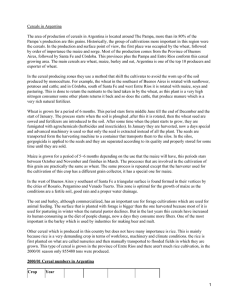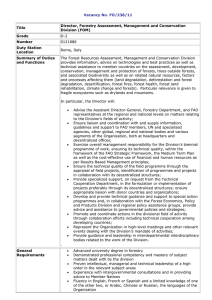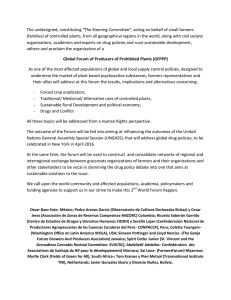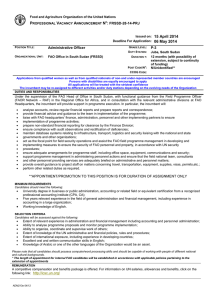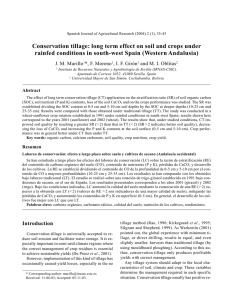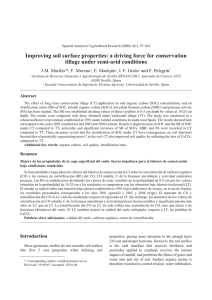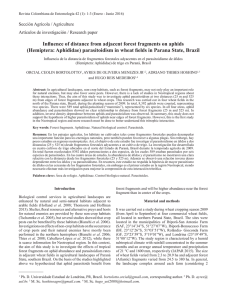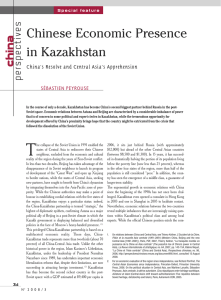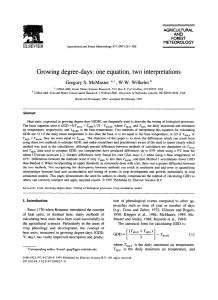Farmers stop ploughing on Kazakhstani steppe
Anuncio
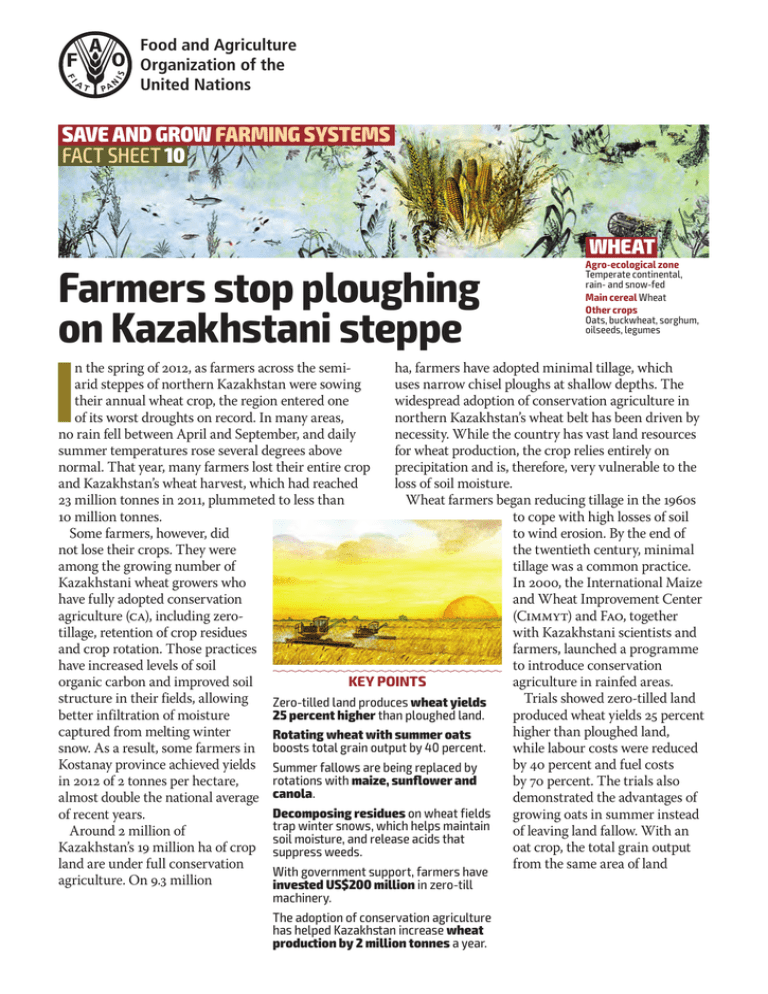
Food and Agriculture Organization of the United Nations SAVE AND GROW FARMING SYSTEMS FACT SHEET 10 WHEAT Farmers stop ploughing on Kazakhstani steppe I Agro-ecological zone Temperate continental, rain- and snow-fed Main cereal Wheat Other crops Oats, buckwheat, sorghum, oilseeds, legumes n the spring of 2012, as farmers across the semiha, farmers have adopted minimal tillage, which arid steppes of northern Kazakhstan were sowing uses narrow chisel ploughs at shallow depths. The their annual wheat crop, the region entered one widespread adoption of conservation agriculture in of its worst droughts on record. In many areas, northern Kazakhstan’s wheat belt has been driven by no rain fell between April and September, and daily necessity. While the country has vast land resources summer temperatures rose several degrees above for wheat production, the crop relies entirely on normal. That year, many farmers lost their entire crop precipitation and is, therefore, very vulnerable to the and Kazakhstan’s wheat harvest, which had reached loss of soil moisture. 23 million tonnes in 2011, plummeted to less than Wheat farmers began reducing tillage in the 1960s 10 million tonnes. to cope with high losses of soil Some farmers, however, did to wind erosion. By the end of not lose their crops. They were the twentieth century, minimal among the growing number of tillage was a common practice. Kazakhstani wheat growers who In 2000, the International Maize and Wheat Improvement Center have fully adopted conservation (Cimmyt) and Fao, together agriculture (ca), including zerowith Kazakhstani scientists and tillage, retention of crop residues and crop rotation. Those practices farmers, launched a programme to introduce conservation have increased levels of soil organic carbon and improved soil agriculture in rainfed areas. KEY POINTS structure in their fields, allowing Trials showed zero-tilled land Zero-tilled land produces wheat yields produced wheat yields 25 percent better infiltration of moisture 25 percent higher than ploughed land. captured from melting winter higher than ploughed land, Rotating wheat with summer oats while labour costs were reduced snow. As a result, some farmers in boosts total grain output by 40 percent. by 40 percent and fuel costs Kostanay province achieved yields Summer fallows are being replaced by rotations with maize, sunflower and by 70 percent. The trials also in 2012 of 2 tonnes per hectare, almost double the national average canola. demonstrated the advantages of Decomposing residues on wheat fields of recent years. growing oats in summer instead trap winter snows, which helps maintain Around 2 million of of leaving land fallow. With an soil moisture, and release acids that Kazakhstan’s 19 million ha of crop suppress weeds. oat crop, the total grain output land are under full conservation from the same area of land With government support, farmers have agriculture. On 9.3 million invested US$200 million in zero-till machinery. The adoption of conservation agriculture has helped Kazakhstan increase wheat production by 2 million tonnes a year. Today, Kazakhstan ranks among the world’s leading adopters of zero-tillage. The area of A three-year study found that forage sorghum sown late in May and harvested in August provided not only fodder for sale or silage, but also left a durable postharvest stubble that was very effective in trapping that precious winter snow. Minimal The adoption of conservation tillage agriculture in Kazakhstan has enabled an Conventional increase in annual wheat production of tillage almost 2 million tonnes, sufficient to feed some 5 million people. Further increases Zero tillage will be possible with the development of high-yielding wheat varieties better 2011 2012 2014 suited to zero-tillage and the north’s harsh winters and increasingly hot summers. That option is being explored through a programme with Cimmyt, which crosses in Mexico local Kazakhstani wheat varieties with Mexican, Canadian and US cultivars. Changes in crop area under different tillage technologies in Kazakhstan (million ha) 14 • land that is no longer ploughed at all rose 12 • from nil in 2000 to 1.4 million ha by 2008. 10 • That increase is attributed to very high adoption rates on large farming enterprises, 8 • 6• where managers are striving to increase production while reducing costs. However, 4 • 2• the approach has also been taken up on 0• small to medium-sized farms, a category 2007 2008 which, in sparsely populated Kazakhstan, ranges from 500 to 2 500 ha. The adoption rate has been particularly high on farms with rich black soils, where high returns provide the capital needed for investment in ca machinery. Under zero-tillage, weeds are often controlled with herbicides. However, many farmers find that combining zero-tillage with permanent soil cover also helps to suppress weeds. The natural store of weed seeds in the soil diminishes over time, and decomposing residues release humic acids, which block the seeds’ germination. After four or five years the incidence of weeds – and herbicide use – decreases considerably. Another advantage of retaining crop residues is that it increases the availability of water to the wheat crop. Annual precipitation ranges from 250 to 350 mm, and winter snow accounts for around 40 percent of it; when the snow is blown away by wind, the soil surface is left bare and dry. Retaining the stubble of the previous wheat crop traps the snow which later melts into the soil. That has two benefits: more moisture is available along the soil profile and erosion is reduced or even eliminated. On-farm research has found that the use of residues to capture snow, along with zerotillage, can increase yields by 58 percent. Progress in the adoption of crop rotation has been slower – the vegetation period on the northern steppes in summer is short, with a high frequency of dry years. However, more farmers are now taking advantage of available – and sometimes abundant – rainfall to grow oats, sunflower and canola. Studies have shown the high potential of other rotational crops, including field peas, lentils, buckwheat and flax. Adapted from: Save and Grow in practice: maize, rice, wheat. A guide to sustainable cereal production (FAO, 2016). ISBN 978-92-5-108519-6 The book can be downloaded in PDF from: http://www.fao.org/3/a-i4009e.pdf For a print copy, write to: [email protected] Conservation agriculture is considered highly suitable for all of Central Asia’s major cropping systems, from north Kazakhstan’s wheat belt down to the irrigated wheat, rice and cotton fields of Uzbekistan and Tajikistan. In recent years, information on conservation agriculture has reached farmers across the region and some ca practices are appearing in their fields. In Uzbekistan, for example, winter wheat is planted into standing cotton on some 600 000 ha. In Tajikistan, direct-seeding of winter wheat after the cotton harvest, with minimum soil disturbance, is practised on some 50 000 ha. Trials conducted recently by an Fao project in Azerbaijan convinced smallholder farmers to adopt conservation agriculture on 1 800 ha of irrigated land. However, most Central Asian countries have no policies to foster ca. They could learn from the example of Kazakhstan, where state policy promotes conservation agriculture, and the top priority in agricultural research is the development and dissemination of water-saving technologies. In 2011, Kazakhstan introduced subsidies on ca equipment that are three to four times higher than those on conventional technologies. Government support has encouraged farmers in northern Kazakhstan to invest an estimated Us$200 million to equip their farms with zero-tillage machinery. Contact Plant Production and Protection Division Food and Agriculture Organization of the United Nations Viale delle Terme di Caracalla, 00153 Rome, Italy [email protected] www.fao.org/save-and-grow © FAO, 2015 I5313E/1/12.15 increased by 37 percent, while soil erosion was much reduced.
